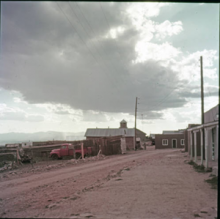Article
Approximately 56.2 million acres of land within the United States are designated as Native American reservations, areas of land set aside for the perpetual use of indigenous groups, many of whom were forcefully relocated onto them. Sometimes reservations are sited on land traditionally used by the people before conquest and colonization. In other cases, Native American reservations are located away from their traditional lands as a result of 18th-, 19th-, and 20th century federally-supported practices that expropriated natural resources, throughfares, and lands under the premises that the land was "vacant," its resources were not being properly exploited, and because of racial biases that privileged European settlement patterns based on ownership rather than fluid and multiple landuse practices.
"Street view on Navajo Reservation near Fruitland, New Mexico, 1953," photograph by John Collier, Jr.. (2006_20_701). Farmington Museum, Farmington, New Mexico.
Manuscripts
References
Castle, George Pierre and Robert L. Bee
1992 State and Reservation: New Perspectives on Federal Indian Policy. Tucson:
University of Arizona Press.
Frantz, Klaus
1999 Indian Reservations in the United States. Geography Research Paper 241. Chicago:
University of Chicago Press.
Kinney, J.P.
1937 A Continent Lost: A Civilization Won: Indian land Tenure in America. Baltimore:
John Hopkins University Press.
Sutton, Imre
1976 Sovereign States and the Changing Definition of of the Indian Reservation.
Geographical Review 66(3): 281-295.

